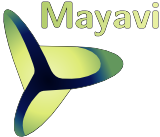Adjust cropping extents example¶
A custom dialog to adjust the parameters of a GeometryFilter to crop data points.
This example shows how to use a GeometryFilter to crop data points, but also how to build a custom dialog to easily set interactively parameters of a filter, or any other Mayavi object.
The GeometryFilter crops all data within a bounding box specified by ‘extents’. In this example, we want to be able to tweak these extents interactively. For this, we build a Traits object that has ‘x_min’, ‘x_max’, ‘y_min’, … attributes. Traits enables us to represent this object as a dialog box. We use a callback called when these attributes are modified to propagate them to the filter. For more information on creating GUIs with Traits:
Python source code: adjust_cropping_extents.py
"""
# Author: Gael Varoquaux <gael.varoquaux@normalesup.org>
# Copyright (c) 2010, Enthought, Inc.
# License: BSD Style.
################################################################################
# Create a set of points, with given density
import numpy as np
x, y, z, s = np.random.random((4, 500))
################################################################################
# A dialog to edit a range interactively and propagate it to the filter
from traits.api import HasTraits, Range, Float, Instance, \
on_trait_change
from traitsui.api import View
class ExtentDialog(HasTraits):
""" A dialog to graphical adjust the extents of a filter.
"""
# Data extents
data_x_min = Float
data_x_max = Float
data_y_min = Float
data_y_max = Float
data_z_min = Float
data_z_max = Float
x_min = Range('data_x_min', 'data_x_max', 'data_x_min')
x_max = Range('data_x_min', 'data_x_max', 'data_x_max')
y_min = Range('data_y_min', 'data_y_max', 'data_y_min')
y_max = Range('data_y_min', 'data_y_max', 'data_y_max')
z_min = Range('data_z_min', 'data_z_max', 'data_z_min')
z_max = Range('data_z_min', 'data_z_max', 'data_z_max')
filter = Instance(HasTraits, allow_none=False)
@on_trait_change('x_min,x_max,y_min,y_max,z_min,z_max')
def update_extent(self):
if (self.filter is not None
and self.x_min < self.x_max
and self.y_min < self.y_max
and self.z_min < self.z_max
):
self.filter.extent = (self.x_min, self.x_max,
self.y_min, self.y_max,
self.z_min, self.z_max)
view = View('x_min', 'x_max', 'y_min', 'y_max', 'z_min', 'z_max',
title='Edit extent', resizable=True)
################################################################################
# Now build the visualization using mlab
from mayavi import mlab
fig = mlab.figure(1, bgcolor=(1, 1, 1))
# Create unconnected points
pts = mlab.pipeline.scalar_scatter(x, y, z, s)
mlab.outline(pts)
# Use a geometry_filter to filter with a bounding box
geometry_filter = mlab.pipeline.user_defined(pts,
filter='GeometryFilter')
geometry_filter.filter.extent_clipping = True
# Connect our dialog to the filter
extent_dialog = ExtentDialog(
data_x_min=0, data_x_max=1,
data_y_min=0, data_y_max=1,
data_z_min=0, data_z_max=1,
filter=geometry_filter.filter)
# We need to use 'edit_traits' and not 'configure_traits()' as we do
# not want to start the GUI event loop (the call to mlab.show())
# at the end of the script will do it.
extent_dialog.edit_traits()
# The geometry_filter leaves hanging points, we need to add a
# CleanPolyData filter to get rid of these.
clip = mlab.pipeline.user_defined(geometry_filter,
filter='CleanPolyData')
# Finally, visualize the remaining points with spheres using a glyph
# module
spheres = mlab.pipeline.glyph(clip, scale_factor=.1)
mlab.show()
